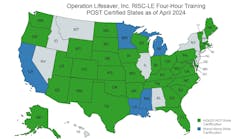It can happen in an instant. Just checking that new email, sending one more text or turning up the music a little louder can take your attention from your surroundings and put you in a potentially dangerous situation, especially when at a bus stop, train station or transportation center.
"More often we are seeing people who are so 'in tune' with their electronic devices that they have no idea where they are going," said SEPTA General Manager Joseph M. Casey. "They are stepping out in front of buses and off of platforms into the track area. It's frightening."
To remind the public of the dangers of being too connected to their smartphones, tablets and other handheld devices, SEPTA made distracted commuting the focus of its second annual “Make the Safe Choice” Safety Awareness Day on May 21. During the morning and afternoon rush hours, 500 Authority employees and City Year corps members distributed educational materials and answered safety questions at 150 SEPTA rail, trolley and bus stations, loops and transportation centers throughout the Authority’s five-county service area. Safety messages were also displayed in the Authority's stations and on its vehicles, including a wrapped 40-foot bus.
“Over the last year, we have responded to a few track falls each month," said Scott Sauer, SEPTA's director of system safety. “That is especially troubling on the Broad Street and Market-Frankford Lines, where not only is the drop from the platform to the track about four feet, there is an electrified third rail. In many cases, our trains are just minutes from entering the stations where the falls had just occurred.”
Surveillance video often shows people (some impaired or under the influence, others talking or texting on their phones or otherwise distracted) walking past the yellow warning strip and landing into the track area.
“These incidents are easily preventable,” said Sauer. “If you must use a phone or other device at a station or bus stop, stand away from the edge of the platform or curb. When you are waiting for the train, stand behind the yellow line. Looking down the platform does not make the train come faster. You can still stand behind the line and see and hear the train coming.”
This is the second year SEPTA has held a system-wide safety day. The Authority is believed to be the first U.S. transit organization to hold such an all-out, one day safety endeavor. But for SEPTA, Safety Day is an everyday occurrence and the event is an extension of SEPTA System Safety’s “Safety Blitz” education program.
“At least once a month, our safety officers visit railroad, rail transit and bus stations across the Authority, reviewing regulations and precautions with thousands of passengers,” said Sauer. “We often visit locations as a result of community request or stations that have had a high volume of passengers or trespassers.”
To complement the Safety Blitzes, SEPTA just launched a safety website geared toward young riders and debuted a video starring the Phillie Phanatic. Copies of the video were sent to local schools and segments are also running at Citizens Bank Park during Phillies’ games.
“We enlisted the help of one of our area’s most beloved mascots to help us deliver our important safety messages in a fun way children can relate to,” said Sauer. “But because everyone loves the Phanatic, we think the video will have a wide appeal.”
SEPTA’s System Safety Department also makes Operation Lifesaver rail safety presentations to students from kindergarten through high school and to a wide variety of audiences such as hearing and visually impaired adults, driver’s education students, emergency responders and professional drivers. SEPTA offers the presentations — which are aimed at reducing the number of pedestrian and driver injuries and fatalities around railroad tracks by highlighting risky behaviors — free of charge to school and community groups.
“We urge more organizations to take advantage of the Operation Lifesaver training we provide,” said Casey. Each program is tailored to the specific audience and includes a slide show, video and question-and-answer session.


